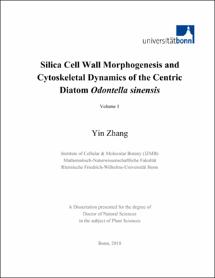Silica Cell Wall Morphogenesis and Cytoskeletal Dynamics of the Centric Diatom Odontella sinensis

Silica Cell Wall Morphogenesis and Cytoskeletal Dynamics of the Centric Diatom Odontella sinensis

| dc.contributor.advisor | Menzel, Diedrik | |
| dc.contributor.author | Zhang, Yin | |
| dc.date.accessioned | 2020-04-26T09:18:23Z | |
| dc.date.available | 2020-04-26T09:18:23Z | |
| dc.date.issued | 25.01.2019 | |
| dc.identifier.uri | https://hdl.handle.net/20.500.11811/7846 | |
| dc.description.abstract | The architecture and the distribution of the cytoskeleton in a diatom cell has not been systematically reported before, and its function during the cell cycle has remained largely unexplored. In this thesis, I used Odontella sinensis as a model, exploring whether and how the cytoskeleton dynamically changes its architecture to regulate silica cell wall morphogenesis and cell growth. First, by using EM observation, I have described the silica deposition process of the frustule wall, and I found fibrous balls functioning as spaces holders during the chamber formation of the areolae. Second, I developed a multiple fluorescent labeling method to visualize the spatial relationship between the SDV (silica deposition vesicle) and the cytoskeleton in a cell. With this method, normal cells at different stages of the cell cycle have been observed and from these data I have derived the tension-equilibrium model of cell growth: The SDV is always developed under the cover of eGB2 (the second girdle band of the epitheca). The cytoskeleton of O. sinensis includes the perinuclear microtubule system and an actin system composed of a cortical network, transaxial bundles and an actin ring. The latter demarcates the edge of the expanding valve SDV, but will eventually be anchored at the junction between eGB1 and eGB2, once it has reached this site. It remains fixed there during girdle band formation. Only when the last girdle band has been made, the actin ring moves away together with the trailing edge of last girdle band during the final phase of cell expansion. In mitosis, the initiation process of a cytokinetic actin ring is reported for the first time by confocal laser scanning microscopy in diatoms. Third, cytochemical localization of chitin by WGA-rhodamine suggests a role of this polysaccharide as a component in the adhesive sealing lace between adjacent frustule parts. The presence of genes in diatoms coding for chitin-synthase-myosin chimeras could explain, how the actin ring inside the cell could link up the chitin lace on the cell surface at the junction between eGB1 and eGB2. Lastly, to learn more about the functions of the two different cytoskeletal systems, I used the inhibitors Oryzalin and Jasplakinolide. The conclusions from these experiments are: Silica deposition is independent of microtubules, but microtubules limit the expansion of the SDV, by a "drag-shoe" mechanism. The cortical actin network stabilizes the SDV membrane preventing premature exocytosis. The geometric pattern of each frustule part relies on the cooperation between the two cytoskeletal systems. The different subsets of the actin cytoskeleton have a graded sensitivity towards JAS: Most sensitive is the cytokinetic actin ring, less sensitive are the cortical and trans-axial actin systems and fairly stable is the SDV-actin ring. In summary, development and shaping of frustule parts in the SDV require the cooperation between both cytoskeletal systems and these processes go hand in hand with axial cell expansion. An incomplete survey of cytoskeletal features in other centric diatoms is provided in the appendix. | en |
| dc.language.iso | eng | |
| dc.rights | In Copyright | |
| dc.rights.uri | http://rightsstatements.org/vocab/InC/1.0/ | |
| dc.subject | diatom | |
| dc.subject | microtubules | |
| dc.subject | actin | |
| dc.subject | SDV | |
| dc.subject | cell wall | |
| dc.subject | silica deposition | |
| dc.subject | cell cycle | |
| dc.subject.ddc | 580 Pflanzen (Botanik) | |
| dc.title | Silica Cell Wall Morphogenesis and Cytoskeletal Dynamics of the Centric Diatom Odontella sinensis | |
| dc.type | Dissertation oder Habilitation | |
| dc.publisher.name | Universitäts- und Landesbibliothek Bonn | |
| dc.publisher.location | Bonn | |
| dc.rights.accessRights | openAccess | |
| dc.identifier.urn | https://nbn-resolving.org/urn:nbn:de:hbz:5n-53230 | |
| ulbbn.pubtype | Erstveröffentlichung | |
| ulbbnediss.affiliation.name | Rheinische Friedrich-Wilhelms-Universität Bonn | |
| ulbbnediss.affiliation.location | Bonn | |
| ulbbnediss.thesis.level | Dissertation | |
| ulbbnediss.dissID | 5323 | |
| ulbbnediss.date.accepted | 21.12.2018 | |
| ulbbnediss.institute | Mathematisch-Naturwissenschaftliche Fakultät : Fachgruppe Biologie / Institut für Zelluläre und Molekulare Botanik (IZMB) | |
| ulbbnediss.fakultaet | Mathematisch-Naturwissenschaftliche Fakultät | |
| dc.contributor.coReferee | Baluška, František |
Files in this item
This item appears in the following Collection(s)
-
E-Dissertationen (4378)





